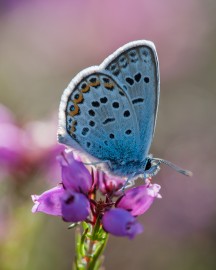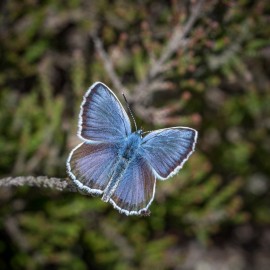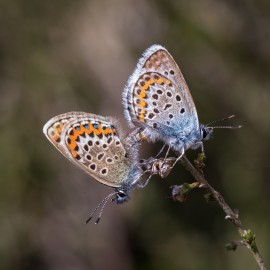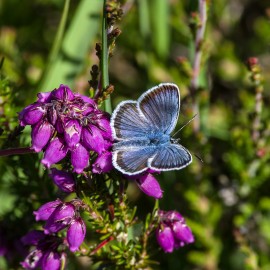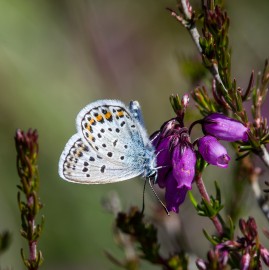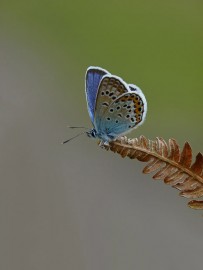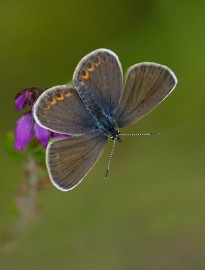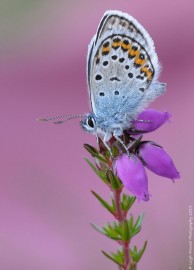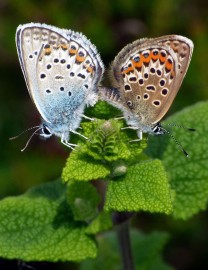by Martin Kalaher
Within this county this lovely little blue butterfly is intimately associated with heathland, but it only thrives in those areas where there is a high-level of focussed, conservation effort. In West Sussex, the largest colonies may be found at Chapel Common (on the West Sussex/Hampshire border) and Iping and Stedham Commons nr Midhurst. In East Sussex, it currently just about hangs on in Ashdown Forest where it is thinly but widely-spread. Since the 1990-1994 atlas recording period it has been lost from a number of sites including Midhurst Common, Ambersham Common, Wiggonholt Common and St Leonards Forest.
In recent years there have been two major initiatives that will hopefully lead to some recovery of what has been lost. The South Downs National Park Authority through its "Heathlands Reunited" project is seeking to restore and re-connect heathland habitat between Woolmer Forest in Hampshire and Pulborough in West Sussex. Much work has already been done with commendable results. The second initiative, "The Ashdown Forest Silver-studded Blue project" was launched by Butterfly Conservation in 2016, initially seeking clarification as to the current status of this species, and then moving on to highly-focussed conservation management by the Conservators of Ashdown Forest, amongst others.
Without a great deal of human intervention, the odds are really stacked against this species surviving on our Sussex heathlands. The first and most obvious problem is the lack of grazing animals on our commons. In a by-gone era the local farmers would have done whatever was necessary to ensure a steady supply of young plant growth for their livestock. The easiest way to achieve this would be by rotational, winter burning so that there was always a patch of land with fresh shoots for the following summer. The second problem is that this species lives in tight, close-knit colonies from which the adults are extraordinarily reluctant to move. Several studies were undertaken in the 1980s when adults were independently-marked, and it was found that few individuals moved more than 20 metres in their short life span, with 50 metres being quite exceptional. This lead to the conclusion that adjacent colonies separated by just 100 metres were to all intents and purposes quite independent of each other. The third problem is the very short life span of individual adults (just 4-5 days) and the potential impact of inclement weather, for just a few weeks of rain and an entire colony could be wiped out.
The male Silver-studded Blue is a very distinctive butterfly. The background colour is a medium inky-blue and it has a wide blackish outer rim, with a pure white fringe. The female is brown with a row of orange lunules along the rear end of the hindwing with variable indistinct orange smudges bordering the forewings. It would be difficult to confuse it with any other British butterfly species.
There is a single generation with the flight period between early June and late August, although following a warm spring the first males may appear in the last few days of May. The average flight period for 2010 and 2014 was 7 June to 17 August, with peak activity the last week of June and the first week of July.
It has an extremely close mutualistic relationship with black ants and research by Mike Edwards in Sussex has highlighted the key species (for the Sussex Weald) as Lasius Platythorax. From the moment the caterpillar hatches from its egg right through all stages of development to the time when the butterfly has inflated and fully dried off its wings, it is tended by ants.
The bluish-white button-shaped egg is deposited at the base of a heather stem or some similar tough vegetation. The female can detect the presence of Lasius ants and the eggs are deliberately laid very close to one of their nests. The embryo develops soon after laying but stays inside the egg over the winter months with the caterpillar emerging the following spring. It is immediately adopted by ants and carried to the subterranean chambers of their nest, where it remains throughout its development. It does venture forth at night (accompanied by its bodyguards) to feed on its food plant, which for the Iping/Stedham colonies seems to be more-or-less exclusively Bell Heather. The caterpillar maintains the close attentions of the ants by secretion of chemicals attractants and sugary food. It remains in the ants' nest as a pupa and hatches after 2-3 weeks. It emerges from the nest, climbs up a stem to dry out with the ants still in attendance as they feed on the butterfly's bodily fluids. Only when dry do the ants seem to lose interest. This species has a truly remarkable life history.
Silver-studded Blues are perhaps only around 10 years of neglect away from becoming extinct as a Sussex species, but no doubt with BC members like Arthur Greenwood (current species champion) and his ilk, to fight its corner, then it should have a bright future.
The best sites to see this species are: Chapel Common SU822287, Iping Common LNR SU846221, Stedham Common LNR SU856217 and Ashdown Forest (Camp Hill) TQ473292.
Find out more about the Silver-studded Blue on the Butterfly Conservation website.



